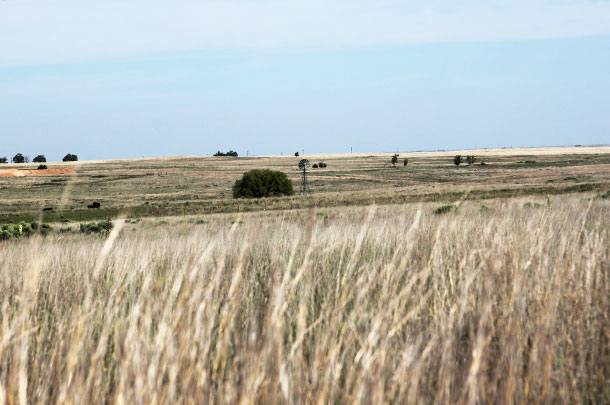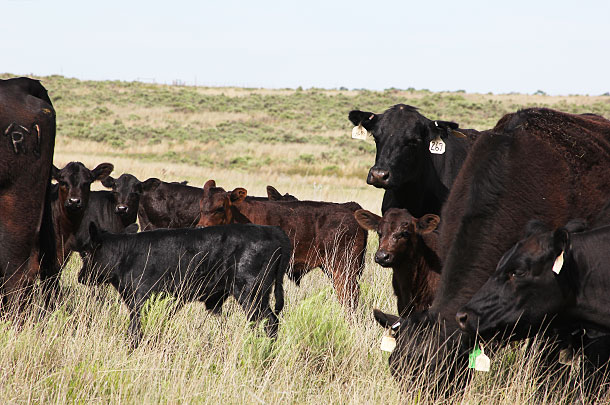Rader Ranch is home to an estimated 400 head of cattle in normal rainfall years, and an abundance of wildlife, including white-tailed deer, pronghorn antelope, blue and bobwhite quail, mourning dove and lesser prairie-chickens.
Although the rains came this year and quenched the thirsty, dry land, Rader says the diversity in his management system didn’t force him to rely completely on rainfall to sustain his land and cattle.
Since he manages the ranch with native rangeland, cropland with native grasses in the Conservation Reserve Program (CRP) and cropland with wheat, his options allowed him to provide livestock forage to sustain much of his herd and help the diverse wildlife live through the drought. The extent of the drought caused Rader to destock or sell yearlings and maintain all of the mother cows on the ranch.
Rader admits his diversity in land uses made a significant difference. He manages 350 acres of cropland wheat to enhance grazing and to grow livestock feed.
Rader refers to his ranch as the “refuge for life,” a place he has always called home. It’s where he and his wife, Linda, raised their three children, Justin, Haley and Sarah, and it’s a way of life and legacy his grandfather started in 1917.
A history of conservation
Learning about the land and what it offers has become Rader’s lifework through the teachings of his father and grandfather. From a young age, he remembers his dad working with the USDA’s Soil Conservation Service, now known as the Natural Resources Conservation Service (NRCS), to help manage the land better.
“NRCS has helped us for 50 years, and they’ve been a strong, reliable source for good advice,” Rader says. “NRCS has never led us in the wrong direction.”
He contends that without diversity on the ranch, grasses are easily overgrazed and especially damaged during periods of drought as shown in the past five years. “Our land is so fragile, and it takes a long time to recover,” Rader admits. “Our cattle are spread out over a number of acres to let pastures rest. We’ve had to whittle down our cattle numbers to keep from overgrazing.”
Initially, he learned the value in management strategies from his dad, who believed in resting pastures. He says his dad would buy land and sometimes not graze it for one year, and he remembers people asking why he wasn’t using the land.
“We expect too much from our land; resting it helps,” he says.

An involved manager
Rader took over the responsibilities of Rader Ranch in 1975, and continued to make progress in planning and implementing conservation practices for livestock and wildlife. One of the biggest challenges for Rader was the invasion of Sand Sage, an invasive brush species. He turned to NRCS for assistance to address the brush problem and focused on practices to benefit his cattle and wildlife.
Through the NRCS Environmental Quality Incentives Program (EQIP), Rader conducted brush control measures to increase his grass, installed water facilities for better grazing distribution, and implemented cross fencing to defer grazing and set up more rotational grazing options.
Mary Foster, NRCS district conservationist for Lipscomb County, has worked with Rader for many years. She states, “He’s always had a conservation plan with us. It’s an integral part of his overall management system.”
Foster has worked with Rader to address resource concerns through means of technical and financial assistance, such as conservation planning and farm bill program assistance. To add to his conservation goals in previous years, Rader was approved for the Conservation Stewardship Program (CStP) and has a prescribed grazing plan. A total resource management plan came later to include all-inclusive acres – a plan developed by NRCS and the High Plains Grazing Lands Coalition (GLC).
A helping hand for wildlife
To further his conservation and wildlife management goals, Rader voluntarily reached out to NRCS to request a conservation plan for predictability, specific to the adoption of conservation practices in the lesser prairie-chicken range.
“I saw what Clint Rollins was doing through the NRCS and Texas High Plains Grazing Lands Coalition, and I wanted to be a part of it,” Rader says. “I see value in finding solutions and being proactive.”
Rader has said many times that he believes what’s good for your land is good for your cattle and the birds.
Clint Rollins, NRCS rangeland management specialist and grazing lands specialist for the GLC, conducted oversight in the development of Rader’s comprehensive conservation plan through the agencies’ Working Lands for Wildlife (WLFW) partnership agreement with the Department of Interior United States Fish and Wildlife Service (USFWS), and through the Texas State Soil and Water Conservation Board’s (TSSWCB) commitment to provide farmers and ranchers like Rader the opportunity to receive predictability or assurances.
“The first thing we did in the planning process was determine if the habitat on Rader’s property was suitable and could be improved to benefit the lesser prairie-chicken,” Rollins says. “From there, we proceeded with a full resource inventory and planned conservation practices, such as prescribed grazing and upland wildlife habitat management, that would improve conditions and benefit the habitat for the bird.”
Rader says, “My plan offers me a way to define all of our resources and grazeable acres. It makes us think about it more and to be more organized with our ranch management.”
NRCS, working through the local soil and water conservation district, prepared a full-scale resource inventory of the ranch. A job like this requires experience to develop maps, detailed forage inventories and thorough documentation of the acreage.
The impacts of drought could have been worse for Rader and his bottom line. Preplanning and good management lessened the effects he would have otherwise faced. He says during the worst part of the drought, he had a 70 percent decline in the deer population on his ranch.
After hearing about the recent decision to reverse the USFWS decision to list the lesser prairie-chicken as threatened under the Endangered Species Act (ESA) by a federal court in Texas, Rader continues with the plans he made to voluntarily work toward improving habitat for the bird and other wildlife species.
According to the Western Association of Fish and Wildlife Agencies, a new range-wide aerial survey shows that the lesser prairie-chicken population has increased across its five-state range by approximately 25 percent from 2014 to 2015.
The NRCS in Texas and the TSSWCB continue to work with private landowners in their conservation planning efforts to increase the lesser prairie-chicken populations. In the past year, NRCS and the TSSWCB have received conservation planning requests for upwards of 200,000 acres. Currently, 11 plans have been completed to address 40,000 acres of habitat, with an additional 40,000 acres of planning nearing completion.
“Wildlife is a part of our life,” Rader says. “My philosophy is we have prairie-chickens on our land and we have to be good stewards of the land for any species. The wildlife needs help. It would be good if everyone would set aside a small amount of acres – perhaps an old farmstead or windbreak area. Even a small amount of refuge for wildlife helps.”
An advocate for conservation
Ranchers like Rader want to know what’s available to them for conserving and enhancing habitat to benefit their operation and the wildlife, such as the lesser prairie-chicken. NRCS’ prairie-chicken conservation efforts are part of the WLFW, the agency’s effort to accelerate conservation for at-risk and listed species while providing regulatory predictability for up to 30 years.
Through the Lesser Prairie-Chicken Initiative (LPCI) and the WLFW, ranchers can continue their conservation work to provide better forage and grazing lands for livestock, and the supporting practices they install can improve a producer’s operation and management.
A number of partners are involved in the effort to pool resources, expertise and strengths to accomplish wildlife conservation through sustainable ranching. Unprecedented cooperation has made a difference for the lesser prairie-chicken and other at-risk species. Partners include conservation districts, nongovernmental organizations, private corporations, land trusts, state wildlife agencies, universities and federal agencies.
With Rader’s conservation ethics, he is making Rader Ranch a “refuge for life” for more than just himself. ![]()
PHOTO 1: Steve Rader says his experience has led him to conclude what’s good for your land is good for your cattle and the lesser prairie-chicken.
PHOTO 2: Rader Ranch headquarters is located in the wide-open spaces near Follet, Texas, in Lipscomb County.
PHOTO 3: Prescribed grazing is one of the practices included in Steve Rader’s conservation plan to receive predictability or assurances. Photos provided by USDA NRCS.






